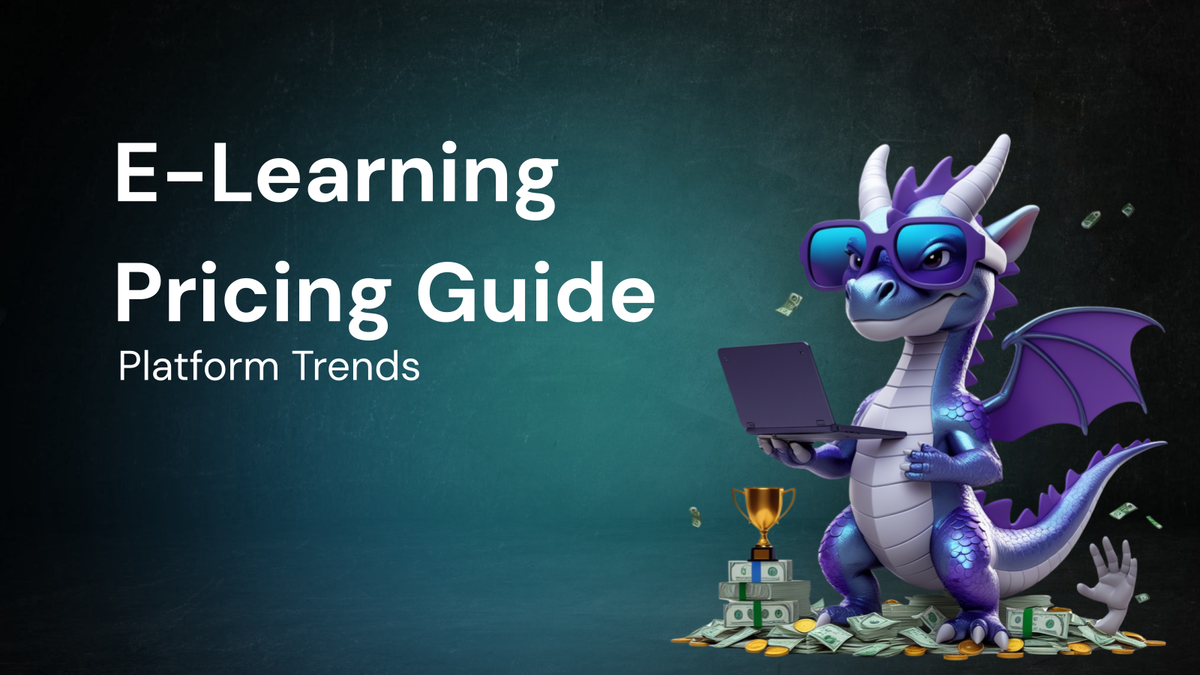Your Guide to E-Learning Platform Pricing Trends

Your Guide to E-Learning Platform Pricing Trends: Navigating the Costs of Online Education
The world of e-learning is booming. Fuelled by increasing accessibility, a desire for lifelong learning, and the flexibility it offers, individuals and organizations are increasingly turning to online platforms for education and training. But with a vast array of platforms available, each boasting different features and functionalities, understanding e-learning platform pricing can be a daunting task. This comprehensive guide aims to demystify the e-learning platform pricing landscape, providing you with the knowledge you need to make informed decisions and choose the platform that best fits your needs and budget.
Why Understanding E-Learning Platform Pricing is Crucial
Before diving into the different pricing models, it’s important to understand why focusing on pricing is crucial. Choosing an e-learning platform is an investment, and like any investment, it needs to be carefully considered. Here's why understanding pricing is paramount:
- Budget Management: Effective budget management is essential, whether you're an individual seeking self-improvement or a large organization training hundreds of employees. Knowing the pricing models and their associated costs allows you to accurately forecast expenses and avoid overspending.
- ROI Maximization: Return on Investment (ROI) is key. You need to ensure that the benefits gained from the platform (enhanced skills, improved employee performance, increased sales, etc.) outweigh the financial investment. Understanding the price structure helps you assess potential ROI.
- Platform Comparison: With numerous e-learning platforms available, comparing their pricing models is crucial for identifying the most cost-effective solution. Simply looking at the headline price can be misleading, as hidden fees or limitations might exist.
- Scalability Planning: Your needs might evolve over time. You need to select a platform with a pricing structure that can accommodate future growth and changing requirements. Understanding the different tiers and their costs allows you to plan for scalability.
- Avoiding Vendor Lock-in: Choosing a platform with a transparent and fair pricing model reduces the risk of vendor lock-in. You want to be able to switch platforms if your needs change without incurring exorbitant penalties or losing your investment.
Key Factors Influencing E-Learning Platform Pricing
Several factors influence the pricing of e-learning platforms. Understanding these factors will help you interpret the different pricing models and compare platforms effectively.
- Platform Features and Functionality: The more features and functionalities a platform offers (e.g., advanced analytics, gamification, social learning tools, custom branding), the higher the price is likely to be.
- Number of Users: Many platforms base their pricing on the number of users (students, employees, instructors) who will be accessing the system. This is particularly common in subscription-based models.
- Storage Space and Bandwidth: Platforms that host large amounts of content (videos, high-resolution images, interactive simulations) may charge based on storage space and bandwidth usage.
- Level of Support: The level of technical support and customer service provided can significantly impact the price. Higher-tier plans often include dedicated support, faster response times, and personalized training.
- Customization Options: Platforms that allow for extensive customization (e.g., custom branding, API integrations, bespoke features) will generally be more expensive.
- Hosting Options: The choice between cloud-based (SaaS) and self-hosted platforms influences pricing. SaaS platforms typically involve subscription fees, while self-hosted platforms require upfront investments in servers and infrastructure.
- Security and Compliance: Platforms with robust security measures and compliance certifications (e.g., GDPR, HIPAA) may command higher prices due to the increased investment required to maintain these standards.
- Integrations: The number and type of integrations with other systems (e.g., CRM, HRIS, marketing automation platforms) can affect the price.
- Content Creation Tools: Platforms that offer built-in content creation tools may charge more than those that rely on external content creation solutions.
- Branding & White Labeling: The ability to fully brand the platform with your own logo and branding elements can increase the price, especially for white-label solutions.
Common E-Learning Platform Pricing Models
The e-learning platform market offers a variety of pricing models. Here's a breakdown of the most common ones:
- Subscription-Based Pricing:
- Description: This is one of the most popular models, where users pay a recurring fee (monthly or annually) to access the platform and its features.
- Variations:
- Per-User Pricing: The fee is based on the number of active users (students, employees). This is suitable for organizations with a fluctuating number of users.
- Tiered Pricing: Different subscription tiers offer varying levels of features, storage, and support, allowing you to choose the plan that best suits your needs and budget.
- Flat-Rate Pricing: A fixed fee provides access to the platform for a specific number of users and features, regardless of usage.
- Pros: Predictable costs, easy budgeting, access to ongoing updates and support.
- Cons: Can be expensive for large organizations, potential for unused features, dependency on the vendor.
- Example: "Basic Plan: $99/month for up to 50 users. Premium Plan: $299/month for unlimited users and advanced analytics."
- Per-Course/Per-Module Pricing:
- Description: Users pay for each course or module they access. This model is often used by individual learners or organizations offering specific training programs.
- Pros: Cost-effective for accessing specific content, no long-term commitment.
- Cons: Can be expensive if accessing multiple courses, limited access to the platform's full functionality.
- Example: "Individual Course: $49. Module Bundle: $199."
- One-Time License Fee (Perpetual License):
- Description: Users pay a one-time fee to purchase the software and own a license for its use. This model is often used for self-hosted platforms.
- Pros: Complete control over the platform, no recurring fees.
- Cons: High upfront cost, responsibility for maintenance and updates, potential for outdated software.
- Example: "One-Time License: $5,000 (includes one year of support and updates)."
- Open-Source Platforms (Potentially Free, but…):
- Description: Open-source platforms are free to download and use, but they often require technical expertise to set up, customize, and maintain.
- Pros: Free to use, highly customizable, community support.
- Cons: Requires technical skills, potential security risks, ongoing maintenance costs (server, hosting, development). "Free" doesn't mean cheap.
- Example: Moodle, Open edX.
- Freemium Model:
- Description: A basic version of the platform is offered for free, with limited features and functionality. Users can upgrade to a paid plan to access additional features and support.
- Pros: Allows users to try the platform before committing to a paid subscription, suitable for small-scale use.
- Cons: Limited functionality in the free version, potential for upselling tactics.
- Example: "Free Plan: Up to 5 courses, 10 users. Upgrade to Premium for unlimited courses and users."
- Usage-Based Pricing:
- Description: Users pay based on their actual usage of the platform, such as storage space, bandwidth, or the number of active courses.
- Pros: Cost-effective for infrequent users, transparent pricing based on actual consumption.
- Cons: Difficult to predict costs, potential for unexpected charges if usage exceeds expectations.
- Example: "$0.10 per GB of storage, $0.05 per GB of bandwidth."
- Custom Pricing:
- Description: Often reserved for enterprise-level solutions, custom pricing involves negotiating a tailored pricing plan based on specific requirements and usage patterns.
- Pros: Flexible and tailored to specific needs, potential for cost savings for large organizations.
- Cons: Requires a detailed needs assessment, can be time-consuming to negotiate, less transparent pricing.
Hidden Costs to Watch Out For
While understanding the main pricing models is crucial, it's equally important to be aware of potential hidden costs:
- Setup Fees: Some platforms charge a one-time setup fee for initial configuration and training.
- Data Migration Costs: Moving existing data to a new platform can incur significant costs, especially for large organizations.
- Training Costs: Training users on the new platform can add to the overall expense.
- Support Costs: Basic support may be included in the subscription fee, but premium support or dedicated account managers may require additional charges.
- Integration Costs: Integrating the platform with other systems can involve development costs and ongoing maintenance fees.
- API Usage Fees: Accessing the platform's API for custom integrations may incur usage-based fees.
- Storage and Bandwidth Overages: Exceeding the allocated storage or bandwidth limits can result in additional charges.
- Cancellation Fees: Some platforms may charge a fee for cancelling a subscription before the end of the term.
- Upgrade Costs: Upgrading to a higher-tier plan can involve a prorated fee or a new contract term.
- White-Labeling Fees: The ability to completely brand the platform (white-labeling) usually comes at an additional cost.
Tips for Choosing the Right Pricing Model
Choosing the right e-learning platform pricing model requires careful consideration of your needs, budget, and long-term goals. Here are some tips to guide your decision:
- Define Your Needs: Clearly identify your learning objectives, target audience, required features, and desired level of customization.
- Assess Your Budget: Determine your budget constraints and prioritize features accordingly.
- Consider Your Scalability: Choose a pricing model that can accommodate future growth and changing requirements.
- Compare Multiple Platforms: Request quotes from several vendors and compare their pricing models, features, and support options.
- Read Reviews and Testimonials: Research online reviews and testimonials to gain insights into other users' experiences with the platform and its pricing.
- Request a Demo or Trial: Take advantage of free demos or trials to test the platform's functionality and usability before committing to a paid subscription.
- Negotiate Pricing: Don't be afraid to negotiate pricing, especially for enterprise-level solutions.
- Read the Fine Print: Carefully review the terms and conditions of the agreement, paying close attention to cancellation policies, hidden fees, and data ownership.
- Consider Long-Term Costs: Don't just focus on the initial price. Consider the long-term costs of ownership, including maintenance, support, and upgrades.
- Prioritize Value over Price: Choose a platform that offers the best value for your money, even if it's not the cheapest option. Focus on ROI.
The Future of E-Learning Platform Pricing
The e-learning platform market is constantly evolving, and so are its pricing models. Here are some emerging trends to watch out for:
- AI-Powered Pricing: Platforms may leverage AI to personalize pricing based on individual learner needs and usage patterns.
- Micro-Learning Pricing: Pricing models may become more granular, with options for paying for individual micro-learning modules or skills-based courses.
- Outcome-Based Pricing: Pricing may be tied to specific learning outcomes or performance improvements.
- Bundled Services: Platforms may offer bundled services, such as content creation, instructional design, and marketing, at a discounted price.
- Pay-as-You-Go Options: More platforms may offer pay-as-you-go options, allowing users to pay only for the resources they consume.
Conclusion
Navigating the e-learning platform pricing landscape can be complex, but by understanding the different pricing models, key influencing factors, and potential hidden costs, you can make informed decisions and choose the platform that best fits your needs and budget. Remember to define your requirements, compare multiple platforms, negotiate pricing, and prioritize value over price. By taking a strategic approach, you can maximize your ROI and unlock the full potential of online learning. The future of e-learning is bright, and with the right platform and pricing model, you can empower individuals and organizations to achieve their learning goals.




